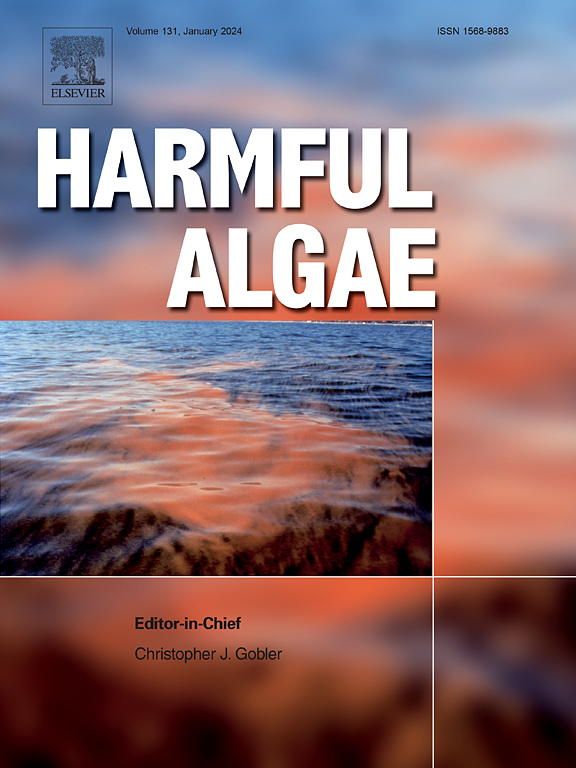集合模型改进了有害藻华和生物毒素风险的近期预测
IF 4.5
1区 生物学
Q1 MARINE & FRESHWATER BIOLOGY
引用次数: 0
摘要
有害藻华对海洋生态系统、水产养殖业和人类健康构成重大威胁。为了减轻这些风险,全球各地的机构根据预期的风险水平进行定期监测并运行早期预警系统。然而,水华动态会受到很大范围的物理和生物因素的影响,导致对未来水华的预测具有很高的不确定性。在这里,我们探索了集合模型预测苏格兰藻华和相关毒素风险的有效性,采用了多种候选模型,包括基于树的方法、神经网络和分层贝叶斯回归。这些模型利用可公开获得的环境产品,结合苏格兰数十个地点的监管监测数据,预测藻类密度或生物毒素浓度在下周超过阈值(交通灯引导系统中的“琥珀色”状态或“检测”状态)的可能性(2015-2022;亚历山大菌,甲藻菌,米克氏Karenia mikimotoi,伪nitzschia [+ delicatissima, serriata群],软骨藻酸(DA),冈田酸/甲藻毒素/果胶毒素(DSTs),麻痹性贝类毒素(PSTs))。从候选模型中预测的概率被用作叠加集成模型的输入。与单个候选模型和零模型相比,集成模型在两年内持续提高了样本外验证数据的预测性能,通过五个不同的性能指标进行评估(指标和目标之间的集成技能得分:平均值= 0.499,中间95% = 0.214-0.900;技能分数给出了比零模型的改进,1表示完美的表现)。性能因监测目标而异,对DSTs的预测最好(平均集成技能:0.747),对K. mikimotoi的预测最差(平均集成技能:0.334)。随着环境条件对藻类密度或毒素浓度的影响,自回归术语和区域时空模式成为最具信息量的预测因子。我们的结果证明了集成方法的明显优势。这些模型的操作实施提供了概率预测,以加强苏格兰的监测计划和早期预警系统。集合建模利用了各种可用的现代技术的综合优势,为改进预测提供了一条有希望的道路。本文章由计算机程序翻译,如有差异,请以英文原文为准。

Ensemble models improve near-term forecasts of harmful algal bloom and biotoxin risk
Harmful algal blooms pose a significant threat to marine ecosystems, aquaculture industries, and human health. To mitigate these risks, agencies around the globe perform regular monitoring and operate early warning systems based on expected risk levels. However, bloom dynamics can be influenced by a large range of physical and biological factors, leading to high uncertainty in predictions of future blooms. Here, we explore the effectiveness of ensemble models for forecasting risk of algal blooms and associated toxins in Scotland, employing a diverse set of candidate models, including tree-based approaches, neural networks, and hierarchical Bayesian regression. These models predicted the probability that algal densities or biotoxin concentrations would exceed a threshold (either ‘amber’ status in the traffic light guidance system, or ‘detection’) in the next week using publicly available environmental products combined with regulatory monitoring data from dozens of locations in Scotland (2015–2022; Alexandrium spp., Dinophysis spp., Karenia mikimotoi, Pseudo-nitzschia spp. [+ delicatissima, serriata groups], domoic acid (DA), okadaic acid / dinophysistoxins / pectenotoxins (DSTs), paralytic shellfish toxins (PSTs)). The forecasted probabilities from the candidate models were used as inputs for a stacking ensemble model. Compared to individual candidate and null models, the ensemble models consistently improved forecasting performance across two years of withheld out-of-sample validation data, as assessed by five distinct performance metrics (ensemble skill scores among metrics and targets: mean = 0.499, middle 95 % = 0.214–0.900; skill score give improvement over the null model, with 1 indicating perfect performance). Performance varied by monitoring target, with best forecasts for DSTs (mean ensemble skill: 0.747) and poorest for K. mikimotoi (mean ensemble skill: 0.334). Autoregressive terms and regional spatiotemporal patterns emerged as the most informative predictors, with effects of environmental conditions contingent on the algal density or toxin concentration. Our results demonstrate the clear advantage of the ensemble approach. The operational implementation of these models provides probabilistic forecasts to enhance Scotland's monitoring program and early warning system. Ensemble modelling leverages the combined strengths of the wide array of modern techniques available, offering a promising path toward improved forecasts.
求助全文
通过发布文献求助,成功后即可免费获取论文全文。
去求助
来源期刊

Harmful Algae
生物-海洋与淡水生物学
CiteScore
12.50
自引率
15.20%
发文量
122
审稿时长
7.5 months
期刊介绍:
This journal provides a forum to promote knowledge of harmful microalgae and macroalgae, including cyanobacteria, as well as monitoring, management and control of these organisms.
 求助内容:
求助内容: 应助结果提醒方式:
应助结果提醒方式:


